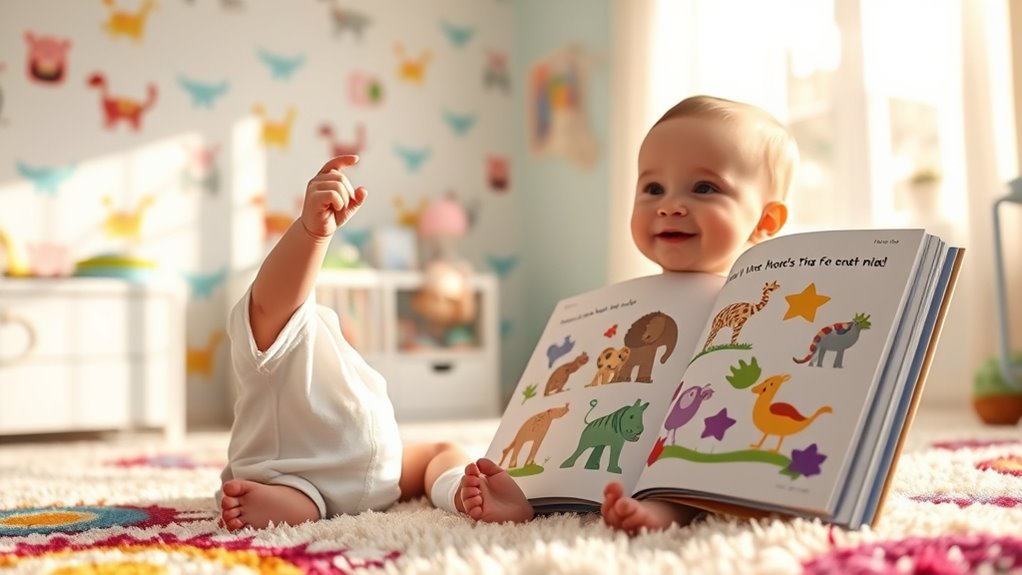To teach your baby to point at pictures, start by choosing books with clear images. While you read, point to the pictures and ask engaging questions, like “Where’s the dog?” This interaction encourages joint attention and vocabulary development. Use outdoor activities to point at objects like birds or trees. Always model pointing behavior yourself and respond when your baby attempts to point, reinforcing their efforts. There’s so much more to explore on this journey of communication.
Key Takeaways
- Choose colorful, clear picture books to capture your baby’s attention during reading sessions.
- Point to images while reading and encourage your baby to mimic your actions.
- Ask questions about the pictures, such as “Where is the cat?” to stimulate interaction.
- Celebrate and respond positively when your baby points to images, reinforcing their attempts at communication.
- Make reading sessions interactive and enjoyable to promote curiosity and engagement with the pictures.

Teaching your baby to point at pictures can be a rewarding experience, as it lays the foundation for communication and language development. You’ll notice that babies usually start pointing between 9 to 12 months old, making this an ideal time to introduce the concept. Pointing is crucial for developing joint attention and serves as a stepping stone to more complex language skills. By actively encouraging your baby to point, you’re promoting their ability to express themselves.
One effective way to encourage pointing is during story time. Choose books with clear, identifiable images, such as animals or toys, and point to the pictures as you read. This not only captures your baby’s attention but also helps them learn to associate words with images. Ask questions like, “Where is the dog?” This invites your little one to participate, reinforcing the act of pointing. Interactive reading makes the experience engaging and enhances their understanding.
You can also incorporate outdoor activities into your pointing practice. While walking, point out objects in nature, like birds or trees. This not only enriches your baby’s vocabulary but also fosters their curiosity about the world around them. Another fun activity is conducting house tours. As you move from room to room, point to familiar objects and label them. This approach creates a natural learning environment and makes the process enjoyable.
Fine motor skills are essential for pointing, and you can develop these through various activities. Bubble play is a delightful way to practice poking skills. Encourage your baby to pop bubbles, which is similar to the motion of pointing. You can also engage in button pressing on toys, poking holes in play dough, or even finger painting. These activities enhance their dexterity while making learning fun.
Modeling pointing consistently is key. Babies learn by imitating adult behaviors, so when you point at objects, they’re likely to follow suit. Make sure to acknowledge and respond when they point. This encouragement reinforces their attempts at communication and shows that you value their efforts. The more you engage in this back-and-forth interaction, the more motivated your baby will be to communicate.
Frequently Asked Questions
At What Age Should I Start Teaching My Baby to Point?
You should start teaching your baby to point around 8 to 9 months, as this is when they begin to understand the function of pointing.
By 9 to 15 months, most babies start pointing themselves.
Encourage this skill by modeling pointing, using objects during playtime, and reading books together.
It’ll help your baby connect words with objects and enhance their communication skills, setting a foundation for language development.
What Types of Pictures Are Best for Teaching Pointing?
Think of pictures as keys unlocking a child’s curiosity. For teaching pointing, you’ll want simple and familiar images like toys or animals.
Clear labels will help connect words to objects, while high-contrast colors keep their attention. Choose images relevant to their world, like family or pets, and ensure they’re large enough to see easily.
Engaging themes, like nature or food, will spark their interest and encourage them to explore and point.
How Can I Encourage My Baby to Point Independently?
To encourage your baby to point independently, create an engaging environment filled with interesting objects.
Use consistent labeling while pointing, so they understand the connection.
Offer opportunities for practice during playtime, like textured books or interactive toys.
Respond positively when they attempt to point, reinforcing their efforts.
Be patient and consistent, as this helps build their confidence and motor skills, making them more likely to point on their own.
Are There Any Signs My Baby Is Ready to Learn?
If you’re wondering if your baby’s ready to learn, look for signs like alertness and curiosity about their surroundings.
Notice if they respond to sounds or try to imitate your gestures. Communication attempts through sounds or movements also indicate readiness.
Engaging in social interactions can enhance these skills, so keep an eye out for these behaviors.
Recognizing these signs will help you know when to start introducing more complex communication.
How Long Should Each Pointing Session Last?
Each pointing session should last just a few minutes to keep your baby engaged.
Short, frequent sessions throughout the day are more effective than one long session.
Pay attention to your baby’s attention span; if they seem distracted or frustrated, it’s time for a break.
You can always return to it later when they’re more focused.
Keep it fun and relaxed to encourage your baby’s interest and participation!
Conclusion
Encouraging your baby to point at pictures not only boosts their communication skills but also enhances their cognitive development. Did you know that babies who engage in pointing at objects tend to have larger vocabularies by age two? This simple gesture lays the groundwork for language and social interaction, helping your little one connect with the world around them. So keep practicing those pointing games—you’re nurturing their growth in ways that will last a lifetime!









